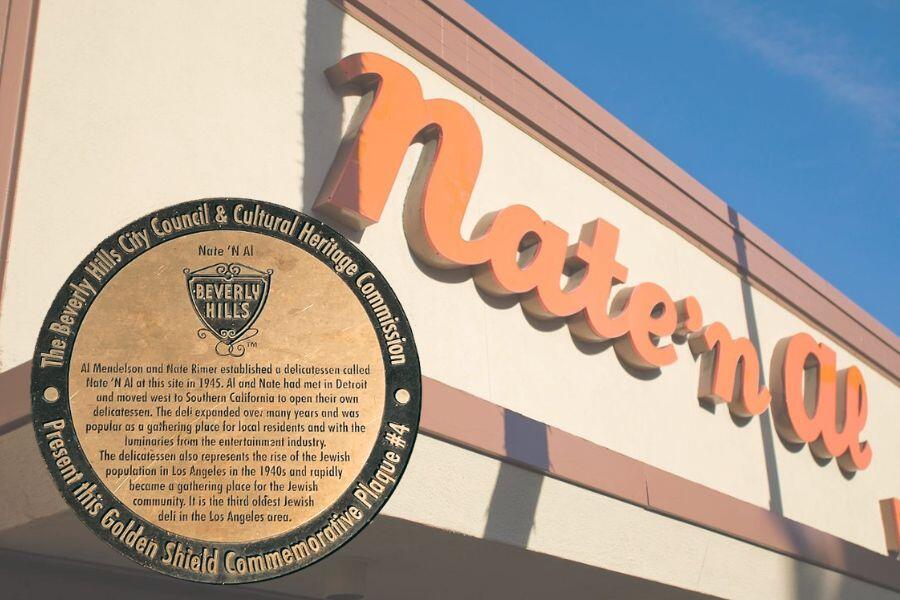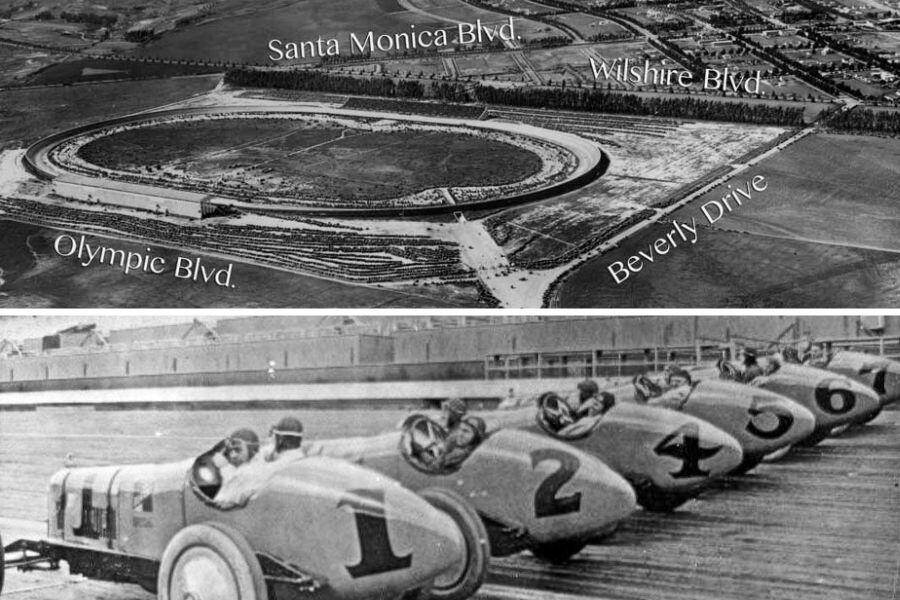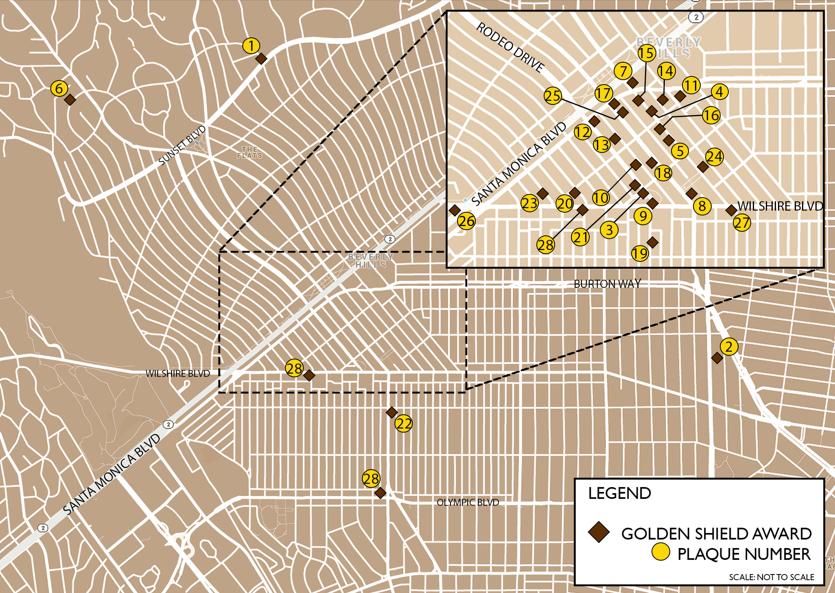Beverly Hills Golden Shield Locations to Discover
Have you noticed plaques around the city labeled “Golden Shield”? In 2019, the Cultural Heritage Commission and the City Council created the Golden Shield Cultural Recognition Program to honor buildings, sites and entities, including long-standing local businesses or organizations, that contribute to the community’s rich history and culture.

To date, 28 locations have been recognized as Golden Shield sites. Here is where you can find golden plaques for current businesses and attractions to learn more about the city’s 100+ year history:
- Brighton Coffee Shop at 9600 Brighton Way: This coffee shop was operated by Lilly Cooper out of a drive-in market and without a formal name. In 1937, the café relocated to the corner at 9600 Brighton Way and was named Brighton Coffee Shop in 1968 and is visited by generations of Beverly Hills residents and Hollywood stars.
- Edelweiss Chocolates/Grace Young’s Candy Roundup on North Cañon Drive: Once named Grace Young’s Candy Roundup before it was bought by Swiss-born Herman Schmidt, Edelweiss opened in 1942 and is one of the oldest confectioners in the United States. And did you know a famous “I Love Lucy” episode with the candy assembly line was inspired by this confectioner?
- Geary’s Beverly Hills on the sidewalk in front of the entry door: Geary’s Beverly Hills first opened its doors in 1930 at 357 North Beverly Drive and was called the H.L. Geary Art & Gift Shop. By the late 1930s, the store, now called Geary’s, had grown substantially and was revamped and expanded in the 1950s to include an ever-growing assortment of exclusive, luxury merchandise.
- Mickey Fine Pharmacy at 433 North Roxbury Drive: First opened in 1956 as a Schwab’s Pharmacy, the Mickey Fine Pharmacy is one of the only remaining pharmacies in the Los Angeles area with a luncheonette counter and soda fountain. It was then expanded to Mickey Fine Pharmacy & Grill making it not only a pharmacy but also a well-known general goods shop with an operational coffee shop.
- Nate 'n Al Delicatessen on the sidewalk in front of the entry door: Nate ‘n Al Delicatessen is situated within the Golden Triangle and has served generations of the Los Angeles area.
- Original Lawry’s Restaurant on the sidewalk at Lawry’s building: Located along what is known as “Restaurant Row,” the upscale steakhouse opened as Lawry’s The Prime Rib in a modest one-story building designed by architect Wayne McAllister. In 1993, the business moved back across the street to an even larger two-story building designed by master architect Gin Wong.
- Pioneer Hardware at 439 North Beverly Drive: Known as the “hardware store to the stars,” Pioneer Hardware was located on North Beverly Drive until its move to Crescent Drive where it operates today. The client list included everyone from Jimmy Stewart to Marilyn Monroe and Sidney Poitier. This is also the place where Gene Kelly bought a pair of roller skates to use in the 1955 movie “It’s Always Fair Weather.”

Golden Shields also honor the legacy of significant sites, homes and businesses that have since closed:
- Ah Fong’s on the sidewalk near the current entry into Bank of America: Established by “The Shanghai Cobra” actor Benson Fong, this eatery was popular amongst celebrities and Beverly Hills residents for its Cantonese cuisine until its closing in 1985.
- Beverly Hills Nurseries on the sidewalk at the "point" created by Wilshire Boulevard and Santa Monica Boulevard: This retail nursery supplied the majority of plantings for the vast landscaping needs of the city.
- Beverly Hills Speedway on the corner of Bedford Drive/Wilshire Boulevard and Beverly Drive/Olympic Boulevard: These plaques mark the public entrance and VIP entrance of the legendary, multi-functional, 1.25mile Beverly Hills Speedway that hosted horse shows, polo games and auto racing events that brought in thousands of visitors to Beverly Hills. The all-wooden speedway was the first track in the United States to be designed with banked turns using a spiral easement curve.
- Carroll & Company on the southeast corner of South Santa Monica Boulevard & North Rodeo Drive: This shield sits where the double door entry of a men’s clothier, favored by everyone from Frank Sinatra to Ronald Reagan, which operated for 43 years and helped establish Rodeo Drive and the Golden Triangle as a retail hub for luxury brands.
- Don Loper Salon at 152 South Rodeo Drive: At this location was the famed couture salon by Don Loper who was known for his lavish gowns and Hollywood glamour. Loper designed pieces for everyone from Ella Fitzgerald to Judy Garland and Joan Crawford. Loper expanded his portfolio to include interior design as he worked on projects including the ballroom at the Beverly Hills Hotel in 1947.
- Doña Maria Rita Valdez de Villa Homestead at the northwest corner of Alpine Drive & Sunset Boulevard: This is considered the first home built in Beverly Hills. Over the years, the Rancho changed owners a few times, but the land that was once Maria Rita’s was officially incorporated as the City of Beverly Hills in 1914.
- Francis-Orr Stationery Co. in front of the entry at 345 North Beverly Drive: This store, one of Beverly Hills’ first women-owned businesses, specialized in elegant products for handwritten notes and letters. The A-List clientele included everyone from Clark Gable to Joan Crawford.
- Gershwin Residence along the frontage of 1019 North Roxbury Drive: Built in 1928, this residence was once home to silent film star Monte Blue and later rented by music icons George and Ira Gershwin, where they penned timeless classics such as “Our Love is Here to Stay.” The property, later owned by notable figures like Ginny Simms and Rosemary Clooney, was demolished in 2005 and made way for a new residence.
- Giorgio Beverly Hills Boutique on the southwest corner of Rodeo Drive & Dayton Way: This location is the first ultra-luxury boutique to be found on Rodeo Drive frequented by notable figures including Elizabeth Taylor and Diana Ross. In 1977, a branch of Louis Vuitton moved to the location.
- Hans Ohrt Lightweight Bicycles on the southeast corner of North Camden Drive and South Santa Monica Boulevard: This bicycle shop served Beverly Hills residents for nearly 40 years. Did you know it was Hans Ohrt who had paths in Beverly Hills legalized and improved for cycling use?
- Harry Harris Shoes for Children on the sidewalk at 418 North Cañon Drive: This store, operated by former professional baseball player Harry Harris, is where many Beverly Hills parents bought their children’s first shoes. The store closed in 2020 following the death of Harry Harris’ son who operated the store since 1991.
- Morocco Junction Station on the mid-block along the east side of North Cañon Drive, between North Santa Monica Boulevard & South Santa Monica Boulevard: On this site was the original inter-urban railway junction named Morocco, which was later subdivided in 1906 to create the City of Beverly Hills. The name then changed to Beverly and later to Beverly Hills and was an important hub for bringing prospective home buyers to the new city.
- Pixie Town on the sidewalk at 365 North Beverly Drive: This beloved store specialized in upscale children’s clothing for over 70 years and offered everything from alterations to special orders and wardrobe consultation for the young travelers and students of the Hollywood stars.
- Romanoff’s centered between Saint Laurent and Moncler storefronts on North Rodeo Drive: Designed by master architect Douglas Honnold, Romanoff’s restaurant opened its doors in 1942 and stars like Marilyn Monroe and Cary Grant made it the town’s hotspot. Today, the building is occupied by Saint Laurent and Moncler.
- The Beverly Theatre/Fiorucci along the sidewalk on Beverly Drive: The Beverly Theater designed by Architect Lewis A. Smith opened in 1925 and was equipped with a Wurlitzer Orchestral piper organ.
- The Bistro on the sidewalk in front of Mastro’s Steakhouse: Opened in 1963, this restaurant was the brainchild of Oscar-winning director Billy Wilder and Kurt Niklas and was funded by many from Hollywood including Dean Martin, Alfred Hitchcock and Jack Benny. The Bistro operated for 31 years before closing its doors.
- The Brown Derby on the northwest corner of Wilshire Boulevard & Rodeo Drive: At this corner was the entry to the Brown Derby Restaurant opened in 1931 by screenwriter Wilson Mizner in partnership with actress Gloria Swanson’s ex-husband and film director Herbert K. Somborn and Warner Brother’s Studio president Jack Warner.
- The Luau on the sidewalk in front of the entry on Rodeo Drive: Famous for over-the-top dining, this was Beverly Hills’ first Polynesian-themed restaurant. The Luau was sold in 1978 and demolished a year later where future high-end boutiques opened their doors.
- Uncle Bernie's Toy Menagerie in front of the original door entry at 309 North Rodeo Drive: This fanciful store was a beloved emporium famous for its lemonade tree and multi-colored lollipop tree that was a popular spot for celebrities and residents to take their children. It later became F.A.O Schwarz before closing in the early 1970s.
- Warner Bros-Beverly Hills Theatre on the sidewalk at the southwest corner parcel of Wilshire Boulevard & Cañon Drive: Designed in an Art Deco style with a soaring neon tower, this 2,000-seat theatre was one of the earliest “movie palaces” built in Beverly Hills and opened its doors with the premiere of the motion picture “The Millionaire”. The architect, B. Marcus Priteca, also designed the Hollywood Pantages Theater.
- Wil Wright’s Ice Cream Shop on the sidewalk in front of the storefront window at 200 South Beverly Drive: On this corner lived the very first of Wil Wright’s Ice Cream shops. It became an instant sensation and celebrity favorite due to its rich flavored ice cream, macrons and old-school charm. Regulars included Marilyn Monroe, Clark Gable, Judy Garland and more.
Want to find more things to do in town? Discover Beverly Hills Activities & Itineraries!
Published January 10, 2024
